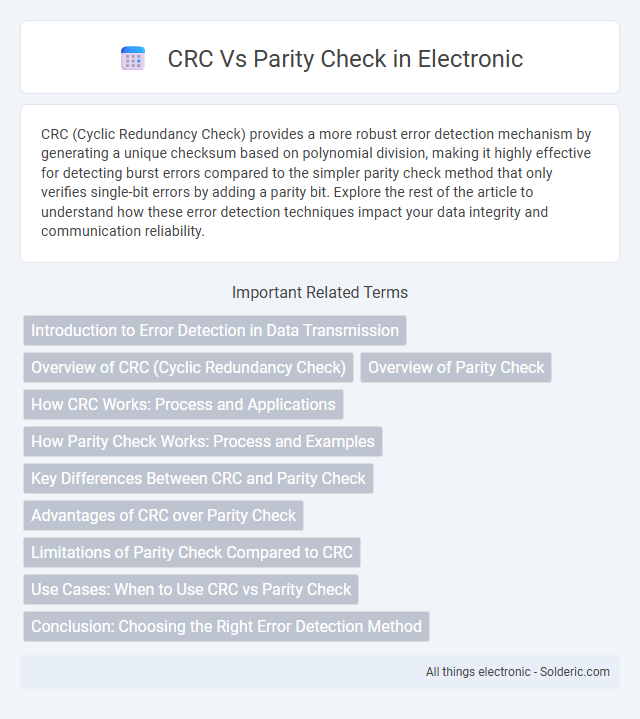CRC (Cyclic Redundancy Check) provides a more robust error detection mechanism by generating a unique checksum based on polynomial division, making it highly effective for detecting burst errors compared to the simpler parity check method that only verifies single-bit errors by adding a parity bit. Explore the rest of the article to understand how these error detection techniques impact your data integrity and communication reliability.
Comparison Table
| Feature | CRC (Cyclic Redundancy Check) | Parity Check |
|---|---|---|
| Error Detection Capability | Detects burst errors and multiple bit errors effectively | Detects only single-bit errors |
| Complexity | Moderate to high computational complexity | Low computational complexity, simple implementation |
| Error Correction | Only error detection, not correction | Only error detection, not correction |
| Implementation | Uses polynomial division, hardware or software-based | Uses a single parity bit added to data bits |
| Data Overhead | Multiple bits depending on CRC polynomial length | One extra parity bit per data unit |
| Use Cases | Network communications, storage devices, digital networks | Simple error checking in memory, communication links with low error rates |
Introduction to Error Detection in Data Transmission
Error detection in data transmission ensures data integrity by identifying errors introduced during communication. Cyclic Redundancy Check (CRC) uses polynomial division to detect burst errors with high accuracy, while Parity Check relies on simpler, single-bit parity to detect odd numbers of bit errors. CRC provides stronger error detection capabilities compared to Parity Check, making it suitable for complex data transmission systems.
Overview of CRC (Cyclic Redundancy Check)
Cyclic Redundancy Check (CRC) is an error-detecting code widely used in digital networks and storage devices to detect accidental changes to raw data. It employs polynomial division to generate a checksum based on the binary data, which helps in identifying errors during data transmission or storage. CRC offers higher accuracy compared to parity checks, making it suitable for applications where data integrity is critical for Your system's reliability.
Overview of Parity Check
Parity check is a simple error detection method that adds a single parity bit to data to indicate whether the number of set bits is even or odd. It is commonly used in communication systems and memory devices to quickly detect single-bit errors with minimal computational overhead. While parity check provides basic error detection, it is less robust than CRC, which can identify more complex error patterns in your data.
How CRC Works: Process and Applications
Cyclic Redundancy Check (CRC) works by treating data as a binary polynomial and dividing it by a predetermined generator polynomial, producing a remainder called the CRC code, which is appended to the data for error detection during transmission. This process enables detection of multiple types of errors, such as burst errors, making CRC highly effective in network protocols, storage devices, and communication systems. CRC applications span Ethernet, USB, and digital television, where robust error-checking ensures data integrity and reliable communication.
How Parity Check Works: Process and Examples
Parity check works by adding a single parity bit to a group of data bits, which helps detect errors during data transmission. The parity bit is set based on whether the number of 1s in the data should be even (even parity) or odd (odd parity), allowing the receiver to verify data integrity by counting the bits. For instance, if you send the data 1011 with even parity, the parity bit will be 0 to maintain an even number of 1s, and any mismatch upon reception signals a transmission error.
Key Differences Between CRC and Parity Check
CRC (Cyclic Redundancy Check) offers robust error detection by using polynomial division to generate a checksum, whereas parity check simply adds a single parity bit to indicate whether the number of 1s is even or odd. CRC can detect burst errors and multiple bit errors with high accuracy, while parity check is limited to detecting only single-bit errors or odd numbers of bit errors. Your choice between CRC and parity check depends on the required error detection strength and complexity of implementation.
Advantages of CRC over Parity Check
CRC offers significantly stronger error detection capabilities than parity check by detecting burst errors and multiple bit errors, which parity checks often miss. The cyclic redundancy check uses polynomial division, providing more reliable and accurate error detection for data integrity in digital communications and storage. Your data benefits from enhanced error detection and reduced chances of undetected errors when using CRC instead of parity checks.
Limitations of Parity Check Compared to CRC
Parity check can only detect an odd number of bit errors, making it insufficient for identifying multiple simultaneous errors, whereas CRC (Cyclic Redundancy Check) detects a wider range of error types including burst errors. CRC uses polynomial division to generate a checksum based on data bits, providing stronger error detection capabilities compared to the simple parity bit method. Your data integrity is more reliably preserved with CRC, especially in environments prone to complex error patterns.
Use Cases: When to Use CRC vs Parity Check
CRC is ideal for detecting complex errors in data transmission over networks and storage devices, ensuring high reliability in systems like Ethernet and digital communications. Parity check is best suited for simple error detection in low-error environments, such as basic memory error monitoring and serial communication. Your choice depends on the criticality of error detection needed, with CRC providing robust accuracy and parity check offering lightweight, fast verification.
Conclusion: Choosing the Right Error Detection Method
CRC offers robust error detection by using polynomial division, detecting burst errors with high accuracy, making it ideal for communication protocols and storage devices. Parity check provides simpler, faster detection of single-bit errors but lacks the capability to identify multiple-bit errors or error bursts, suitable for low-complexity systems. Selecting the right method depends on system requirements for error sensitivity, computational resources, and data integrity priorities.
CRC vs Parity check Infographic

 solderic.com
solderic.com